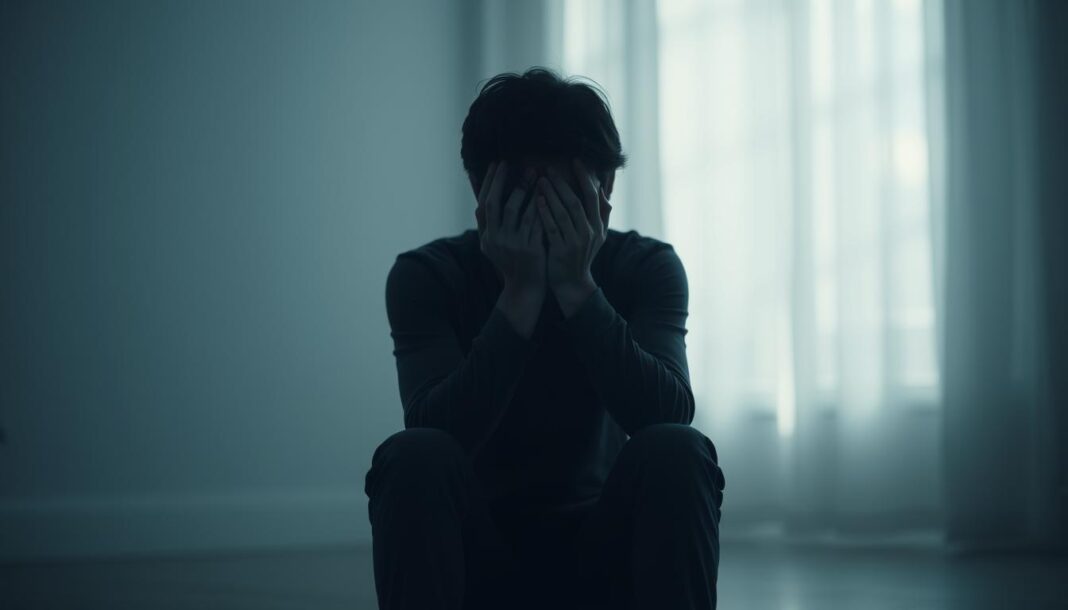Ever felt stuck after a breakup, searching for closure that never arrives? You’re not alone. Many face challenges moving on without the clarity they seek.
The pain of missing closure can be tough, making it hard to heal and move forward. Without closure, you’re left with many questions. This makes it difficult to let go.
It’s key to understand the emotional toll of missing closure. Acknowledge your feelings and the situation’s complexity. This helps you start healing without closure.
Understanding Closure and Its Importance
Seeking closure is a common human need. It’s about finding resolution and healing emotionally. Closure helps you deal with your grief when something ends.
What Exactly Is Closure?
Closure means bringing something to an end or finding a resolution. In relationships, it’s about understanding why things ended. Closure is key for emotional healing, helping you move on.
Why We Crave Resolution
You want resolution for a sense of finality. It lets you put the past behind you and look to the future. Without it, you might feel stuck, unable to heal from emotional pain.
The Psychological Need for Endings
The need for endings is part of human psychology. It’s about wanting clear answers or resolutions. This need is crucial for your emotional health, helping you understand and find peace.
Knowing how important closure is can help you deal with tough times. It promotes healing and growth.
Common Situations Where Closure Is Denied
Closure is key to moving on from big life events or relationships. When we don’t get it, it’s tough to deal with the emotions. This can affect our lives a lot.
Ghosting in Relationships
Ghosting is when someone suddenly stops talking without saying why. It’s common today. The person being ghosted feels confused and unsure of what they did wrong.
Sudden Loss Without Goodbyes
When we lose someone suddenly, like in an unexpected death, we miss out on closure. Not having a chance to say goodbye makes grieving harder.
Unresolved Workplace Conflicts
Workplace conflicts that don’t get solved can also block closure. Disagreements with coworkers or supervisors can leave us feeling stuck. This makes it hard to move forward at work.
Family Estrangements
Family conflicts can also deny us closure. Family ties are deep, making it hard to resolve issues. This can make healing even more challenging.
When we face these situations, finding ways to cope is essential. Realizing that closure can come from within is a big step towards healing.
The Emotional Impact of Being Denied Closure
Being denied closure can feel very disorienting. It leaves you with a mix of emotions that are hard to deal with. Not being able to resolve a situation or say goodbye can cause a lot of negative feelings.
Lingering Grief and Confusion
The lack of closure often leads to lingering grief. You’re left to deal with the loss without a clear end. This can make you feel confused and stuck, unable to move on.
Rumination and Overthinking
Without closure, you might keep thinking about the situation. You’ll replay it in your mind over and over. This can turn into a cycle of overthinking, making it hard to heal emotionally.
Self-Blame and Questioning
Denial of closure can also make you blame yourself. You might wonder if there was something you could have done differently. This self-blame is harmful and needs to be addressed in your healing journey.
Why Some People Withhold Closure
When people deny others closure, it often shows their own emotional battles. They might not want to give closure for many reasons. These include emotional avoidance and power dynamics.
Avoidance of Difficult Emotions
Some people avoid giving closure to dodge their own feelings. It’s a way to avoid guilt, shame, or sadness. This helps them cope with tough emotions.
Power and Control Dynamics
Withholding closure can be a way to control others. It keeps them in limbo. This is true when the person feels they’ve lost control or power.
Their Own Unresolved Issues
People may find it hard to give closure because of their own emotional baggage. This makes it tough for them to face the situation directly. As a result, the other person is left without closure.
| Reasons for Withholding Closure | Impact on the Individual | Effect on Relationships |
|---|---|---|
| Avoidance of difficult emotions | Temporary emotional relief | Prolonged uncertainty and distress |
| Power and control dynamics | Sense of control or power | Damaged trust and potential estrangement |
| Unresolved personal issues | Increased internal conflict | Strained or complicated relationships |
Recognizing When You’re Stuck in the Closure Gap
Knowing when you’re struggling without closure is the first step to healing. This lack can show up in many areas, like personal relationships or work conflicts. It’s key to spot the signs that you’re stuck.
Signs You’re Struggling Without Closure
If you can’t stop thinking about an unresolved issue, you might be struggling. You might replay conversations or wonder about different choices. This persistent preoccupation can drain your emotions and stop you from moving on.
Other signs include feeling lingering grief or confusion. You might also find it hard to make decisions because of the unresolved issue. Feeling ‘stuck’ in your life is another sign.
The Difference Between Processing and Ruminating
It’s important to know the difference between processing and ruminating. Processing means actively engaging with your feelings and slowly coming to terms. Ruminating is passively dwelling on negative thoughts without healing.
How Long Is Too Long?
How long to grieve or process varies for everyone. But if it’s been months to a year or more, and you’re still stuck, it’s time to seek help.
How to Heal When Closure Is Denied: Core Strategies
Healing without closure means focusing on personal growth and acceptance. When you don’t get the resolution you want, you must find new ways to move on. This involves changing how you see things and using strategies that help you heal and feel better.
Accepting That Closure May Never Come
The first step is accepting that closure may never come. This can be hard because it means some questions won’t be answered and some wounds won’t fully heal. But, accepting this can help you grow personally and focus on healing and moving on.
Reframing Your Expectations
Changing your expectations is key. Let go of needing a specific outcome or resolution. Instead, focus on what you can control. By reframing your expectations, you can see that healing is possible without closure. It’s about finding ways to move forward even without answers.
Finding Meaning Without Answers
Finding meaning without answers means looking beyond the need for closure. It’s about learning from your experiences and using them for personal growth. Reflect on the experience, find any positive outcomes or lessons, and use them in your life. This way, you can find your own closure, even if it’s not what you expected.
By using these strategies, you can start to heal and move forward, even without closure. This journey needs patience, self-compassion, and a willingness to adapt. But with the right approach, you can find healing without closure and keep growing and feeling well.
Creating Your Own Closure Rituals
You can heal emotionally by making your own closure rituals. Taking control when others don’t give you closure is empowering. These rituals help you process your feelings and move on.
Writing Unsent Letters
Writing unsent letters is a great closure ritual. It lets you express your feelings and thoughts without needing a reply. Writing down your emotions can be a cathartic experience, helping you release feelings and gain new insights.
Symbolic Ceremonies and Rituals
Symbolic ceremonies are also powerful for closure. You might light a candle, bury an object, or do a small ceremony. These rituals can provide a sense of finality and help you transition to a new chapter in your life.
Visualization Techniques
Visualization is another useful tool for closure. Imagine a positive outcome or moving past the hurt. Regular practice can help your brain heal and move forward.
| Ritual Type | Description | Benefits |
|---|---|---|
| Writing Unsent Letters | Expressing feelings and thoughts in a letter that won’t be sent | Cathartic release, clarity, and emotional closure |
| Symbolic Ceremonies | Performing a symbolic act to mark the end of a chapter | Provides a sense of finality, aids in transitioning |
| Visualization Techniques | Imagining a positive outcome or a healed state | Promotes emotional healing, rewires the brain |
By using these closure rituals, you can take charge of your healing. This helps you move forward with more ease.
The Role of Forgiveness in Healing
Forgiveness can help you move on when you’re denied closure. It doesn’t mean forgetting or agreeing with the past. Instead, it’s about letting go of the emotional weight it carries. This is key for emotional healing and personal growth.
Forgiving Others vs. Forgiving Yourself
Forgiveness can be for others or yourself. Forgiving others means letting go of anger and resentment. Self-forgiveness is about forgiving yourself for past mistakes.
Both are vital for healing. Self-forgiveness is crucial because it helps you accept your part in the situation. It lets you move forward without being held back by guilt.
When Forgiveness Isn’t Possible
In some cases, forgiveness is hard or unhealthy. If the hurt is deep or the other party won’t apologize, forgiveness can be tough. It’s important to remember that forgiveness is a personal choice and shouldn’t be forced.
Instead of focusing on forgiveness, you can work on your healing. This means taking care of yourself and finding ways to move forward. You can acknowledge your feelings and experiences without letting them define you.
Forgiveness is a complex journey. It’s about finding a path to healing and peace, whether it’s forgiving others or yourself. Understanding forgiveness’s role can help you recover and grow.
Practicing Radical Acceptance
Radical acceptance helps you heal without closure. It means accepting reality as it is, without judgment. This is very helpful when you can’t get closure.
What Is Radical Acceptance?
Radical acceptance is about fully accepting your situation, even if it’s hard. It’s about knowing some things are beyond your control. You choose to accept them instead of fighting or denying them.
Techniques for Embracing Uncertainty
To practice radical acceptance, try these techniques:
- Mindfulness meditation to stay present
- Journaling to process your emotions
- Self-compassion exercises to be kind to yourself
- Acceptance-based coping statements
Finding Peace in the Unknown
Radical acceptance helps you find peace in uncertain situations. It doesn’t mean you approve of what happened. It means you stop fighting it.
As you practice, you may heal faster. You’ll move forward more easily.
Radical acceptance is a journey, not a one-time thing. It takes patience, self-awareness, and letting go of resistance. By doing this daily, you’ll find more peace and resilience.
Self-Care Practices for Healing Without Closure
When you don’t get closure, taking care of yourself is key to healing. Healing without closure means using strong self-care plans. These plans help with your body, mind, and relationships.
Physical Self-Care Strategies
Physical self-care boosts your overall health. This includes regular exercise, eating well, and sleeping enough. Physical activity helps your body and mind by lowering stress and anxiety.
Some good physical self-care actions are:
- Yoga or tai chi for relaxation and flexibility
- Cardiovascular exercises like walking, running, or cycling to boost mood
- Strength training to improve physical resilience
Emotional Regulation Techniques
Emotional regulation is key when you don’t get closure. Mindfulness meditation, deep breathing, and journaling help manage your feelings. They also cut down on thinking too much about things.
| Technique | Description | Benefits |
|---|---|---|
| Mindfulness Meditation | Focuses on the present moment | Reduces stress, improves emotional regulation |
| Deep Breathing Exercises | Slow, deliberate breathing | Calms the nervous system, reduces anxiety |
| Journaling | Writing down thoughts and feelings | Processes emotions, gains clarity |
Setting Healthy Boundaries
Setting healthy boundaries is crucial for your emotional health, when closure is denied. It means telling others what you need and sticking to it.
Here are some ways to set healthy boundaries:
- Identifying your emotional triggers and limits
- Communicating your boundaries clearly to others
- Being consistent in enforcing your boundaries
Rebuilding Your Narrative
You can change your story by becoming its author. When closure is hard to find, taking control of your story is key. It helps with healing and growing.
Becoming the Author of Your Story
Being the author of your story means owning your experiences. You can’t change the past, but you can change how you see it. This involves reflecting on your experiences and finding lessons and growth.
Reframing Past Experiences
Reframing means seeing your past in new ways. You find new insights and positive sides you missed before. This makes tough times easier to handle.
| Reframing Techniques | Description | Benefit |
|---|---|---|
| Positive Reframing | Finding the silver lining in a negative situation | Enhances resilience |
| Cognitive Reappraisal | Changing the way you think about a situation | Reduces emotional distress |
| Narrative Reframing | Changing the story you tell about a situation | Fosters personal growth |
Creating New Meaning
Creating new meaning means finding purpose in your experiences. By integrating the lessons learned, you move forward. Your experiences become a source of strength and wisdom.
When to Seek Professional Help
Healing without closure can be tough. Sometimes, you need more than just self-help. A mental health professional can offer the support you need to deal with hard emotions.
Signs You Might Need Therapy
If you’re feeling stuck in grief, confusion, or anger, it’s time to get help. These feelings can make everyday life hard. Look out for these signs:
- Having trouble sleeping or focusing because of the situation
- Feeling distant from friends and family because of your mood
- Using harmful behaviors to cope
- Feeling so overwhelmed that you can’t do anything
Types of Therapy That Can Help
There are many therapies that can help with lack of closure. Here are a few:
- Cognitive Behavioral Therapy (CBT): Changes negative thought patterns
- Acceptance and Commitment Therapy (ACT): Helps accept emotions while staying true to values
- Psychodynamic Therapy: Looks into why you feel and act certain ways
Finding the Right Mental Health Professional
Finding the right therapist is key. Look at their experience, approach, and how you feel about them. Ask lots of questions during your first meeting.
By seeking professional help and finding the right therapist, you can heal. You can move forward even when closure is denied.
Moving Forward: Life After Acceptance
Moving on after not getting closure is tough but also changes you. Accepting that closure might not come is a big step. It marks the start of a new chapter in your life. You’ll find new ways to heal and grow as you journey on.
One key part of moving forward is rebuilding trust in others. It’s hard to trust after not getting closure. But, it’s crucial for healing and moving on. Start by making small connections and then build bigger ones.
Rebuilding Trust in Others
Rebuilding trust means being open to new people and experiences. It’s about building a support network for future challenges. Joining groups or clubs that interest you can help you meet new people and form connections.
Opening Yourself to New Experiences
Being open to new experiences is vital. This could mean trying new hobbies, traveling, or taking on new work challenges. It helps you move past past hurts and find new passions and strengths.
- Explore new hobbies or activities that you’ve never tried before.
- Travel to new places, whether locally or internationally.
- Take on new challenges at work or in your personal projects.
Carrying Lessons Forward
As you move forward, remember to carry the lessons you’ve learned. Reflecting on your experiences can show you how resilient and capable you are. These lessons can help you make better choices and build healthier relationships.
By growing personally, moving past past hurts, and embracing new experiences, you can live a more fulfilling life. This journey needs patience, self-compassion, and courage. But the rewards are worth it.
Conclusion
You’ve looked into how important closure is in life. When we don’t get closure, healing can be tough. But, it’s possible to heal and grow without it.
Accepting that closure might not come can help. You can find meaning without all the answers. Creating your own rituals, accepting fully, and rewriting your story are key steps.
These actions help you move on, even without closure. Remember, healing is a journey that keeps going. Focus on self-care, forgiveness, and trust in others.
By doing this, you’ll carry the lessons learned forward. You’ll open up to new experiences and a more fulfilling life.



